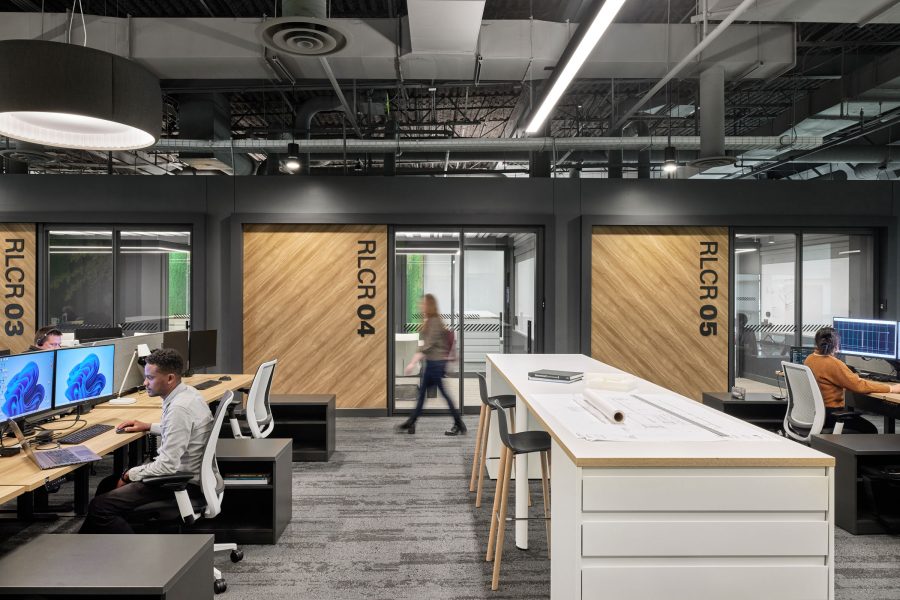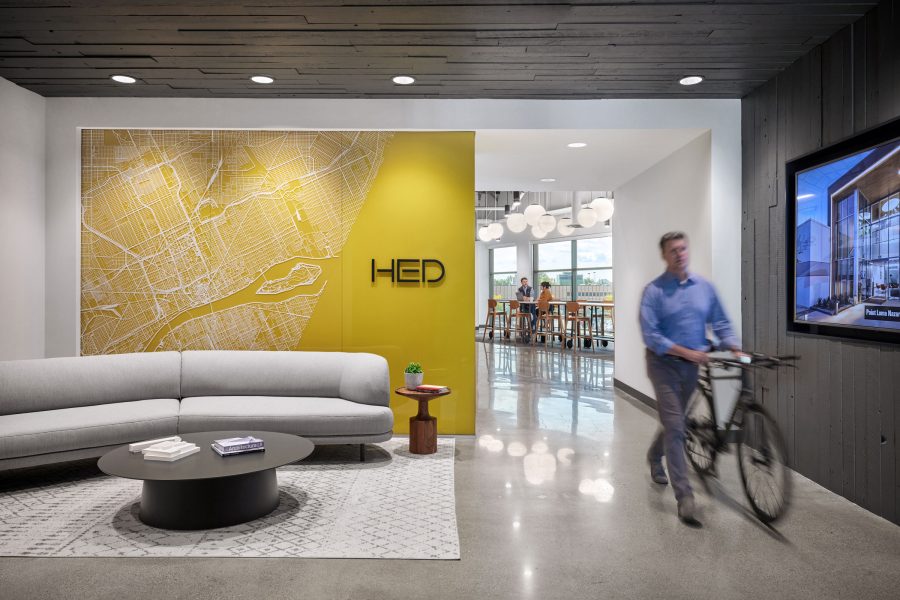Story at a glance:
- A company-wide restructuring inspired a shift in HED’s priorities, making its office relocation an opportunity to focus less on client storytelling and more on the holistic experience of everyone who enters.
- For HED, sustainability and wellness go hand-in-hand, which is partly why the company is pursuing WELL certification. The firm’s new office is a commitment to the future, incorporating sustainable materials and systems that directly influence the well-being of its team.
- With assigned desking and permanent project settings a thing of the past, HED was able to focus on new activity-based, hybrid programming flush with advanced, user-friendly technologies.
For years HED was a small tenant in a large building in a sea of parking. Like many companies, the architectural design and engineering firm in Detroit seemed to prioritize the clients’ front-door arrival experience over, say, the staff’s happiness and workability. When the time came for HED to decide whether to move, their 100-person team made clear they wanted to stay—on one condition.
“Everyone voted for a walkable city where they could feel connected to something bigger than the firm itself, where they could be part of a community with different benefits and amenities,” says Tim Gawel, HED associate principal. So the company packed up and moved to Royal Oak, a midscale urban arts community on the outskirts of Detroit also known as a core retail district.
Now on the second floor of a multi-tenant building, HED’s Detroit office boasts 20,000 square feet overlooking Main Street and the railroad tracks—a vital artery in the city. “We’re in this rich urban environment, swept up in the momentum of watching people walking by on the streets below, and you feel connected to something bigger than just HED,” Gawel says.
A Gathering Space

Photo courtesy of HED
Like many companies in recent years, HED recognized a necessary shift from traditional offices with assigned desking and physical project settings to multi-faceted workspaces catering to undulating employee schedules and virtual collaborations across markets and time zones. “It gave us the chance to consider why people come together, which really came down to programming in a different way,” Gawel says. “We used to program by headcount; you had so many people or you needed so much of this or so much of that. Our new office design is really about being hybrid. Every setting has a multitude of ways the space can be used.”
After riding a bike to work or finding parking at street level, staff and clients enter HED’s new Detroit office the same way—through the studio, a park-like setting with ample natural lighting, grand outdoor views, comfortable benches, and various workspaces. “We created a space intended to bring you back to nature, mixing real plant materials with billboards featuring landscapes instead of architecture. The billboards are more of a psychological symbol of being in green, and having the green illustrated in such a fun, artsy way roots the company in what the Royal Oak community is all about while also understanding, from a human behavior standpoint, that green matters,” Gawel says.
HED continued with its varied programming by designing workspaces based on railcars and cabins, two themes that reflect the company’s new location—both on the tracks in the heart of the city and also within reach of the quieter solitude of cabins up north. “We have railcars where the team can jump in from both sides, where people want to work together without interrupting others around them,” Gawel says.
Wellness & Sustainability

A shift from permanent project settings and assigned desking to virtual collaboration and flexible programming allowed HED to create more of a park-like work environment specifically designed for socializing. “People come together to enjoy what’s around them and be part of something,” says HED associate principal Tim Gawel. “But in the new office, staff and guests can still work on their own thing, observing the people around them without necessarily having to work elbow to elbow.” Photo courtesy of HED
From the beginning HED was dedicated to pursuing the high standards required of WELL buildings. “A lot of what might be celebrated as sustainable moves are just a course of action for HED,” he says. “We chose to pursue WELL certification because it required us to be more consistent over time, making a significant commitment to staying on track.”
WELL certification is a performance-based system for measuring, certifying, and monitoring features of the built environment that impact human health and well-being through seven core areas—air, water, nourishment, light, fitness, comfort, and mind.
Gawel says the worlds of sustainability and wellness are merging. “On the one hand you have materials and systems, while on the other hand you have human behavior, and we know so much more now about how these pieces fit together,” he says. “Wellness is everywhere. Wellness is not disconnected from sustainability; they’re rooted together.”
You feel connected to something bigger than just HED.
HED worked to find value in the new building’s existing constructs, opting not to throw away things that could be reconsidered or repurposed. “Why put more metal studs and drywall into the landfills?” They focused on what was salvageable and what could be reinvented, including carrying over furniture from the old office instead of selecting new styles.
While some decisions challenged the budget, the team was able to adjust to stay on target. Better lighting solutions and controls were implemented in-house by HED lighting designers, including fixtures that stabilize human circadian rhythms. “Gasser Bush Associates was an important partner in enabling us to manage the lighting on our own,” Gawel says.
The company also added VRF to the building’s existing HVAC system—a super-efficient upgraded mechanical system that provides cooling and heating to individual zones, allowing for better temperature control and user adjustability. This zoning capability helps optimize energy consumption and reduce waste. The company also concentrated on using low-VOC materials when possible and focused on AIA 2030, a set of standards and goals for reaching net zero emissions in the built environment.
“Wellness is powerful,” Gawel says, and it’s at every turn at the new office—from bike storage to acoustics to facilities for mothers. “It’s why we pursued WELL certification. It’s why we’re guiding our clients through sustainable projects, because it matters to us. We had an opportunity to lead by example, and we took it.”
Project Details
Project: HED Detroit headquarters
Location: Royal Oak, MI
Completion: 2023
Size: 19,700 square feet
Architect: HED
General Contractor: PCI Dailey
Lighting Design: Gasser Bush Associates
Certifications: Pursuing WELL

HED’s new office space in Detroit shows clients how programming can be done differently. “Clients right now are struggling with how to create flexibility,” says HED associate principal Tim Gawel. “We’re showing them how a space that might look like it’s designed for 35 people can be used for 85.” Photo courtesy of HED

Photo courtesy of HED


